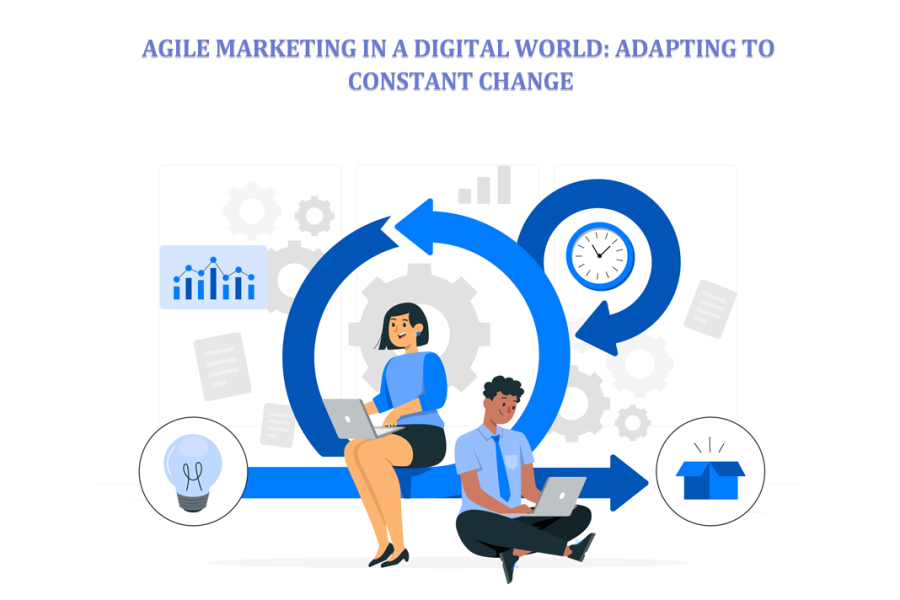Agile Marketing in a Digital World: Adapting to Constant Change
It’s 2024 already. If you’re still using traditional marketing campaigns, you need to switch over to agile marketing now. Those outdated strategies are like an elephant in the cheetah race. The cheetah in this metaphor is representative of agile marketing. It is the solution to the relentless churn of the online landscape, where the average lifespan of a social media trend is relatively short.
Using data-driven insights, a customer-centric approach, and rapid iterations, agile marketing enables your brand to change approaches quickly as needed. This article is a comprehensive guide to agile marketing, highlighting the benefits and challenges of this strategy, along with methods for overcoming those challenges. We’ll also discuss the future of agile marketing to study where trends will lead us.
The Rise of Agile Marketing
Let’s begin by focusing on the importance of agile marketing- its core principles, benefits, and use of technology for this type of marketing.
Core Principles of Agile Marketing
The digital landscape is fast-paced, but traditional marketing is slow. This contradiction in speed ensures that the conventional approach is ineffective. Thus, agile marketing, with its ability to quickly switch approaches based on data-driven insights, is vital to use. Every click and conversion is a factor for intelligent insights, leading to maximized ROI.
Agile marketing has iterative cycles consisting of testing, learning, and adaptation. This ensures that campaigns evolve alongside customer preferences and market fluctuations.
The third core principle of agile marketing is customer-centricity. It means that this marketing approach focuses on individual needs and desires instead of on broad demographics. This personalization secures deeper engagement, in turn fostering loyalty and brand advocacy. Tools like WooCommerce Show Stock Quantity integrate seamlessly, providing up-to-date inventory information for dynamic campaign adjustments and personalized offer presentations.
With these core principles, agile marketing ensures that your business has a loyal following even with the ever-shifting economic situation.
The Benefits of Agile Marketing
Agile marketing is beneficial in many ways, some of which are as follows:
- Lightning-fast adaptation
- Boosted customer satisfaction
- Reduced risk and uncertainty
- Drives innovation
- Maximized ROI
- Streamlined workflows
- Reduced stress and burnout
It is important to remember that the true power of agile marketing is not in these individual benefits but in their synergistic effects. By embracing agile marketing, businesses can create a dynamic and adaptive marketing engine that thrives in the evolving online world and uncertain economic situations.
Embracing Agility through Technology
A robust tech arsenal empowers agile marketing’s transformative approach. It includes marketing automation platforms and collaboration tools.
Marketing automation platforms enable streamlined workflows, automate repetitive tasks, and unleash a torrent of real-time data. With each action analyzed, agile marketers can make informed adjustments in real time, outpacing even the most dynamic trends. Imagine slashing prices instantly to match competitor discounts or crafting emergency campaigns to capitalize on unexpected consumer trends.
Communication platforms replace siloed departments and slow-moving email chains. Agile marketing teams thrive on instant information sharing and cross-functional collaboration, ensuring swift responses and shared ownership of success. Thus, agile marketing is not merely a tactical shift; it’s a cultural revolution. It requires embracing experimentation, celebrating failure as a learning opportunity, and fostering a growth mindset within teams. By embracing the agile marketing revolution, brands can sprint ahead of the competition, navigate the ever-changing digital landscape, and build lasting relationships with their customers.
Challenges of Agile Marketing and Strategies for Overcoming Them
In this section, we’ll look at some challenges businesses may face when embracing agile marketing. We’ll also study the strategies you can adopt to overcome the obstacles.
Challenges in Agile Marketing
Agile marketing promises plenty of benefits- if you can overcome the challenges you may face. These challenges include:
- Cultural Shift
At its very core, agile marketing demands a cultural shift. You’ll have to leave the comforts of what you’re used to and embrace experimentation. Silos are replaced by cross-functional collaborations, propelling your team forward. This cultural transformation requires open minds, willing hearts, and a deep-seated comfort with the ever-changing online landscape.
- Structural Roadblock
Siloed departments and lengthy approval processes are roadblocks within the agile marketing process. They delay critical adjustments when the market demands quick decisions. Risk-averse mindsets need to be overcome, too.
- Technological Limitations
Technology, while enabling agile marketing, can also become a tangled mess. Limited data analytics and outdated infrastructure may limit your marketing. These technological limitations require careful handling, ensuring that every tool plays its part.
- Talent Gap
Even with all other problems overcome, there can be no agile marketing without skilled employees. Limited data literacy, lack of cross-functional collaboration, and lack of knowledge of agile methodologies mean that your workers will be unable to perform as needed. Bridging this talent gap demands dedicated training to foster a team that can understand agile marketing and work well together.
Strategies for Overcoming Challenges
Scaling the peak of agile marketing demands not just a nimble mindset but also a complete reconstruction of your foundations.
For this, you will need to:
- Build an Agile Mindset
This step can be accomplished through targeted training programs and interactive workshops. These sessions will teach your employees about methodologies for agile marketing, fostering a culture of learning and experimentation. Open communication across all levels is also necessary. Continuous feedback and transparency are required to build a foundation of trust and collaborative innovation.
- Restructure Foundations
You need to restructure foundations to overcome challenges effectively. Create cross-functional teams composed of members with shared goals who will be able to respond to market shifts with lightning speed and creative energy.
Also, decentralize decision-making by empowering lower levels with the authority to make data-driven decisions. This shifts the focus from hierarchical approvals to swift reactions, ensuring your team can adapt quickly to new situations without having to wait for the lengthy approval processes to be completed.
- Invest in Technology
This step includes equipping teams with powerful data analytics platforms. Such tools provide real-time insights to fuel intelligent campaign adjustments and optimize every step. Marketing automation tools and flexible content management systems are also crucial for success.
- Upskill your Workforce
Upskilling your workforce requires training programs for your workforce. It enables them to gain diverse skills and varied perspectives. Also, seek out talented workers, individuals with a natural curiosity and a thirst for experimentation.
You should also facilitate knowledge transfer through mentorship programs. Pair seasoned veterans with eager newcomers, fostering a culture of continuous learning.
The Future of Agile Marketing
Having conquered the challenges of adopting agile marketing, a breathtaking vista unfolds before us. This is the horizon of the agile marketing future, painted with vibrant hues of automation, hyper-personalization, and symbiotic connections across business frontiers.
AI-powered automation enables workers to free up time for more creative tasks. Data analysis, content generation, and even optimization cycles are made simpler, allowing humans to focus on personalized brand storytelling.
Hyper-personalization allows agile marketing to transcend its current iteration, crafting experiences that resonate at the individual level. Content, offers, and interactions will adapt to the evolving needs and desires of each unique audience member, transforming marketing into a real-time conversation between brand and customer in the language of their digital journey.
With the creation of symbiotic connections across business frontiers, agile marketing allows you to harmonize sales, customer service, and product development. Data will flow effortlessly, insights will be shared, and strategies will be aligned, creating business success where every department moves together perfectly.
Conclusion
In turbulent times, traditional marketing, like an elephant, is slow and vulnerable. Agile marketing, the digital cheetah, dances with data, adapting in real-time. It minimizes risk, ignites innovation, and thrives on change. Embrace agility, outrun uncertainty, and redefine success. It will enable your brand to become the best.
Share It on :





